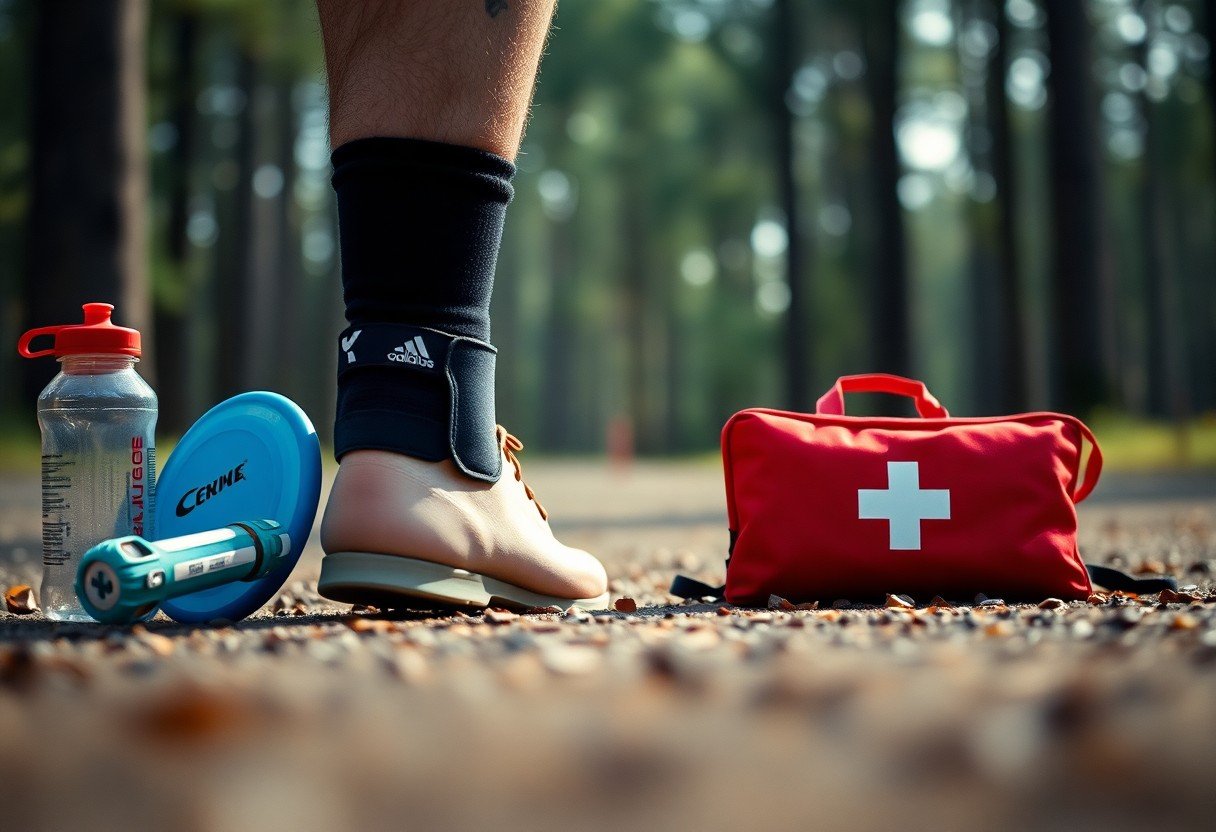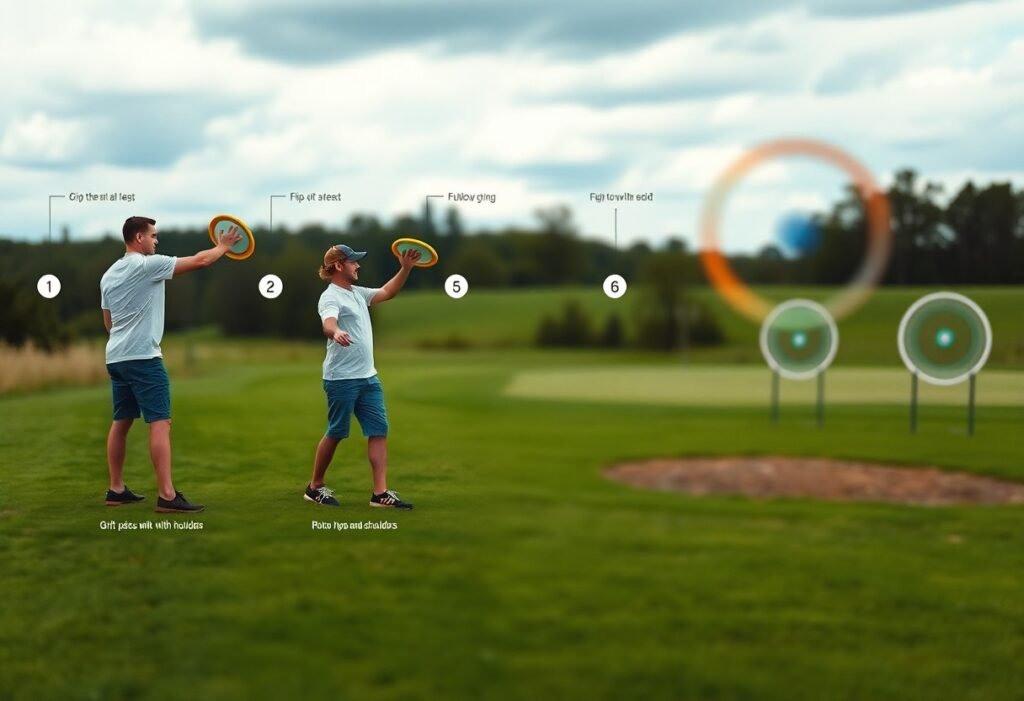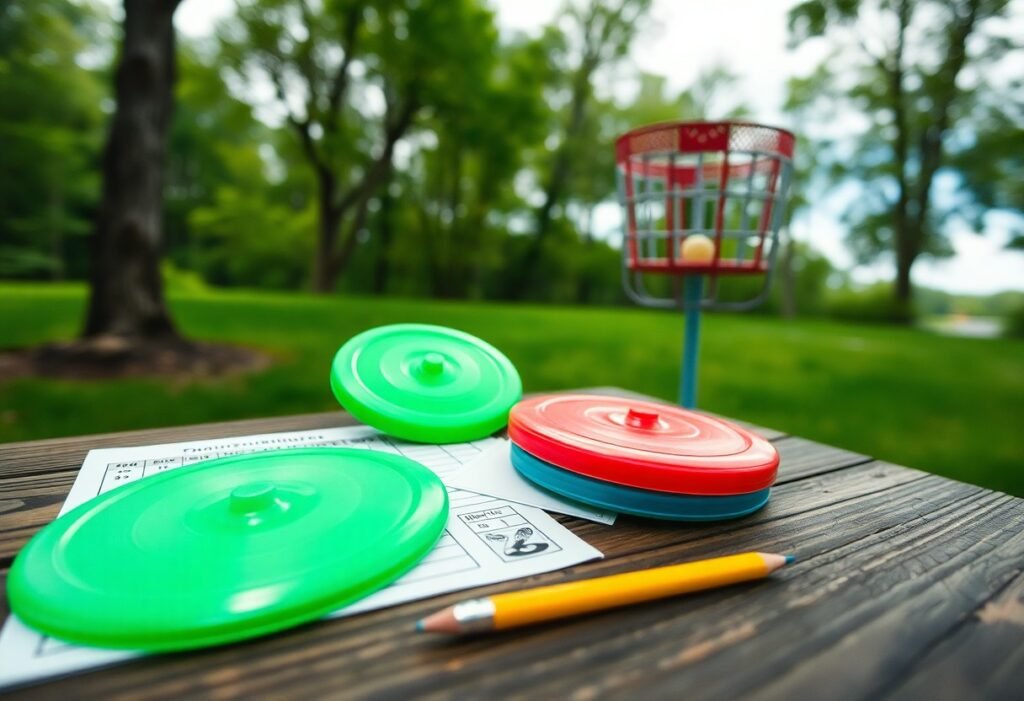Over time, engaging in disc golf can lead to a variety of injuries if you’re not cautious. This guide helps you understand the most common disc golf injuries, along with effective prevention strategies and recovery techniques to keep you on the course. By prioritizing proper form, warming up correctly, and listening to your body, you can significantly reduce the risk of serious injuries. Emphasizing safe practices will allow you to enjoy the game you love while maintaining your physical health and performance.
Key Takeaways:
- Engage in a proper warm-up routine to prevent muscle strain and improve flexibility.
- Use appropriate footwear and maintain proper form during throws to reduce joint stress.
- Incorporate rest and recovery techniques, such as stretching and ice application, to aid in healing.

Understanding Disc Golf Injuries
Common Types of Disc Golf Injuries
You’ll often encounter several common types of injuries while playing disc golf. These can range from acute injuries due to specific accidents to chronic issues caused by repetitive motions. Some prevalent injuries include:
| Shoulder Strains | Overhead throws can lead to muscle strains. |
| Wrist Sprains | Improper disc release may cause wrist injuries. |
| Knee Pain | Bad footing can result in ligament strains. |
| Back Pain | Poor mechanics may strain your back. |
| Ankle Sprains | Uneven terrain can easily cause ankle injuries. |
Perceiving these injury types early can help you adjust your technique or seek treatment before they escalate.
Causes of Injuries in Disc Golf
Injuries in disc golf commonly arise from poor mechanics, inadequate conditioning, or environmental factors. Many players lack proper warm-up routines or overexert themselves, leading to strains and sprains. Additionally, uneven terrain and obstacles can contribute significantly to falls and impacts.
Transitioning into a deeper understanding, common causes include throwing techniques that neglect proper form, resulting in undue stress on specific muscle groups. Engaging in disc golf without a solid warm-up can compromise your body’s ability to handle the physical demands. Factors such as fatigue from lengthy rounds or inadequate footwear increase the risk of injuries. Addressing these issues is key to longevity in the sport.
Prevention of Disc Golf Injuries
Proper Warm-up Techniques
Before heading to the course, take time to perform dynamic stretches that target your shoulders, back, and legs. Incorporate movements such as arm circles, torso twists, and lunges to prepare your muscles and joints for the physical demands of throwing. A proper warm-up increases blood flow, enhancing your flexibility and range of motion, ultimately reducing the risk of strains.
Skill Development
Working on your throwing technique not only improves your game but also mitigates the risk of injury. Focus on your grip, stance, and release mechanics. Spending time with a coach or using video analysis can help pinpoint inefficient movements that may lead to overuse injuries.
Engaging in regular practice sessions leads to muscle memory development and increases your control over throwing distances and angles. You should practice different types of throws and work on consistency, as proper technique reduces unnecessary strain on your body. Enrolling in clinics or workshops with experienced players can accelerate your learning curve and further enhance your skills.
Strength and Conditioning
Incorporating a structured strength and conditioning program can significantly enhance your performance while reducing injury risk. Focus on exercises that strengthen your core, shoulders, and lower body, as these are critical in executing powerful and controlled throws.
A comprehensive strength program should include weightlifting, plyometrics, and agility drills. Incorporate resistance bands or free weights to improve specific muscle groups, aiming for a balanced regimen that promotes muscular endurance and stability. Core stability exercises, like planks and medicine ball work, play a vital role in maintaining proper posture and technique during your rounds.
Equipment Selection
Choosing the right discs is vital to keeping your game both effective and safe. Discs come in various weights and materials, each impacting your throwing mechanics.
Opt for discs that fit your hand comfortably and suit your skill level. Heavier discs might provide more distance but can lead to strains if you’re not accustomed to them. Look for lightweight options, especially if you’re a beginner or have previous injuries. Ensuring your equipment is tailored to your physical abilities and throwing style can mitigate stress on your body while enhancing performance.
Course Management
Effective course management involves knowing your limits and planning your shots strategically. Assess each hole and choose the appropriate disc and throw type based on your strengths and weaknesses.
Take note of your fatigue levels throughout the round and adjust your pace accordingly to avoid overexertion. Prioritizing smart shot selection minimizes risk by reducing aggressive throws that may lead to injuries. Understanding when to play conservatively versus taking risks is vital in both maintaining your health and improving your overall game performance.

Recovery from Disc Golf Injuries
Initial Response to Injury
When you experience a disc golf injury, your initial response is vital. Implement the R.I.C.E. method: Rest, Ice, Compression, and Elevation. This approach reduces swelling and alleviates pain in the early stages. Immediately cease all activities and avoid putting weight or stress on the affected area to promote swift recovery and prevent further damage.
Rehabilitation Strategies
Your rehabilitation strategy should focus on restoring functionality and strength. Start with gentle range-of-motion exercises, progressively increasing intensity as tolerated. Engaging a physical therapist can provide tailored exercises that cater to your specific injury, ensuring a safe path to recovery.
As you recover, implementing a structured rehabilitation program is crucial. This may include physical therapy sessions alongside a personalized exercise routine that enhances strength, flexibility, and endurance in the injured area. Employing activity-specific drills can help recondition your muscles for the demands of disc golf, ultimately preventing future injuries.
Nutrition and Healing
Your diet plays a significant role in recovery. Focus on consuming a balanced intake of protein, healthy fats, and crucial vitamins to promote tissue repair. Foods rich in omega-3 fatty acids, such as fish and flaxseeds, aid in reducing inflammation while colorful fruits and vegetables supply antioxidants for optimal healing.
Incorporating specific nutrients is key to a speedy recovery. For instance, vitamin C contributes to collagen formation, crucial for tissue repair, while zinc supports immune function. A well-rounded diet that includes these nutrients can significantly expedite your healing process and enhance overall recovery from your disc golf injuries.
Mental Recovery Techniques
Mental recovery techniques are equally important as physical healing. Engaging in visualization can aid in rebuilding confidence and preparing your mind for a return to play. Meditative practices, such as mindfulness, will help manage anxiety and maintain focus during recovery.
Utilizing mental recovery techniques like visualization can be incredibly effective. Picture yourself successfully completing your disc golf routine, which can reinforce positive outcomes and combat feelings of frustration or doubt. Additionally, engaging in mindfulness can provide clarity and reduce stress levels, creating a more favorable mindset as you progress through your recovery journey.
Long-term Injury Management
Monitoring Progress
To effectively manage long-term injuries, regularly assess your recovery by documenting your pain levels, mobility, and overall performance. Use a journal or an app to track improvements or setbacks, allowing you to adjust your rehabilitation plan as needed. This proactive approach can help you stay motivated and informed about your physical condition.
Continuous Conditioning
Building a routine that focuses on strengthening and flexibility is crucial for long-term injury management. Engaging in exercises specific to your injury and overall fitness can enhance your performance on the course while minimizing recurrence risks.
Implementing a balanced training regimen that includes both strength training and aerobic conditioning will support your body’s recovery. For example, incorporate low-impact activities like swimming or cycling, alongside resistance exercises aimed at specific muscle groups used during disc golf. This approach not only reduces the chance of re-injury but also promotes stability and endurance, crucial for improving your game.
Adjusting Disciplinary Techniques
As you navigate injury recovery, it’s important to revisit and adapt your training techniques to fit your current capabilities. This may involve reducing the intensity or frequency of your practice sessions. Tailoring your activities to your stages of healing will foster better long-term outcomes.
Adaptations may include modifying your throwing mechanics or altering practice schedules. For instance, introducing alternative activities like yoga can enhance flexibility and prevent stiffness, while also allowing you to stay engaged in your fitness journey. Prioritizing adjustments will enable you to progress without undue stress on your body, ensuring that you’re prepared for a return to full competition.
Disc Golf Injury Myths and Facts
Common Misconceptions
Many players believe that injuries are an inevitable part of disc golf, often attributing them to the sport’s nature. However, it’s a misconception that injuries only occur due to competitive play or advanced skills. In reality, poor techniques and inadequate warm-ups contribute significantly to injury risks. Understanding that even recreational players can face injuries due to their form is key to prevention.
Evidence-based Practices
Utilizing evidence-based practices can significantly reduce your risk of injury while enhancing your performance. Research indicates that focusing on specific warm-up routines, such as dynamic stretching and mobility exercises, can prepare your muscles and joints for the physical demands of the game. Incorporating strength training for core stability and flexibility workouts can also help maintain your body’s resilience against strains.
Additionally, studies highlight the effectiveness of maintaining proper throwing mechanics to diminish stress on your shoulders and back. Adopting a gradual progression strategy in your practice sessions allows your body to adjust to increased intensity, ultimately promoting long-term health. Regular assessments from a physical therapist or coach can guide you in refining your technique and addressing any weaknesses, further enhancing your performance while minimizing injury risks.

Community Support and Resources
Finding Local Support Groups
Connecting with local disc golf communities can offer invaluable support. Look for clubs or organizations in your area, as many host regular meet-ups and workshops. Engaging with fellow players not only provides encouragement during recovery but also enables you to share experiences and gain insights into preventing injuries. Consider reaching out via social media platforms or community boards to find a group that aligns with your interests and goals.
Seeking Professional Help
If you’re dealing with a significant injury, consulting a professional is important. A physical therapist or sports medicine specialist can provide tailored advice, rehabilitation exercises, and strategies for reintroducing disc golf into your routine safely. They can assess your unique situation and craft a recovery program that optimally supports your healing process while minimizing the risk of future injuries.
Research shows that personalized recovery plans developed with professionals can significantly reduce the time needed to return to play. For example, a study revealed that players who followed structured rehabilitation programs reported an 85% return to athletic activities without recurring injuries. Don’t hesitate to seek an expert opinion, as their guidance can make a profound difference in your recovery journey.
Conclusion
Considering all points, you should prioritize prevention and recovery strategies to enjoy disc golf safely. Focus on proper warm-ups, use appropriate equipment, and be aware of your limits to minimize the risk of injuries. In case of an injury, take the time to recover fully before returning to play. For more insights on avoiding injuries in disc golf, check out Ouch: A Look At The Injury Bug, And How To Avoid It.
FAQ
Q: What are the most common injuries in disc golf?
A: The most common injuries in disc golf include shoulder strains, elbow tendinitis, wrist injuries, and lower back pain, often caused by repetitive throwing motions and improper form.
Q: How can I prevent shoulder injuries while playing disc golf?
A: To prevent shoulder injuries, focus on proper throwing techniques, incorporate strength training for the shoulder muscles, and include regular stretching and mobility exercises in your routine.
Q: What is the best way to warm up before playing disc golf?
A: A proper warm-up should include dynamic stretches targeting the shoulders, legs, and core, along with light throwing practice to prepare your body for the game.
Q: How can ice therapy help with disc golf injuries?
A: Ice therapy can help reduce swelling and numb pain after an injury. Applying ice for 15-20 minutes every few hours can assist in the recovery process.
Q: What recovery techniques are effective for elbow tendinitis?
A: Effective recovery techniques for elbow tendinitis include rest, ice application, compression, elevation, and physical therapy exercises to increase strength and flexibility.
Q: Should I seek professional help for recurring injuries?
A: Yes, seeking professional help from a physical therapist or sports doctor is advised for recurring injuries to receive a proper diagnosis and tailored treatment plan.
Q: What role does proper footwear play in preventing injuries?
A: Proper footwear provides adequate support, grip, and cushioning, helping to reduce the risk of ankle sprains and provide stability during play, which can prevent other injuries as well.











